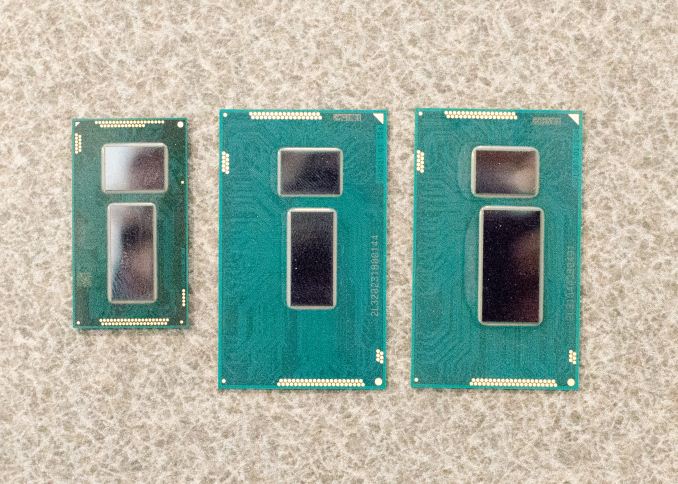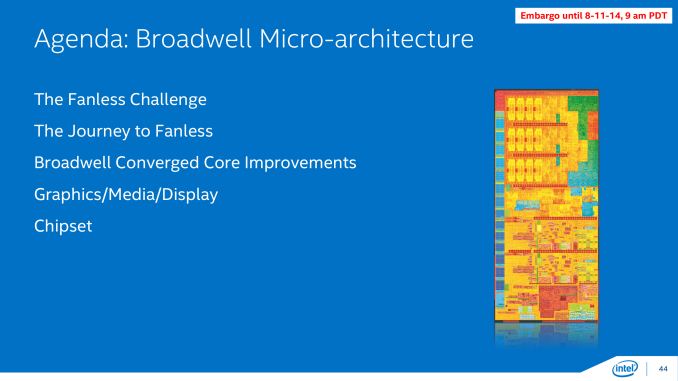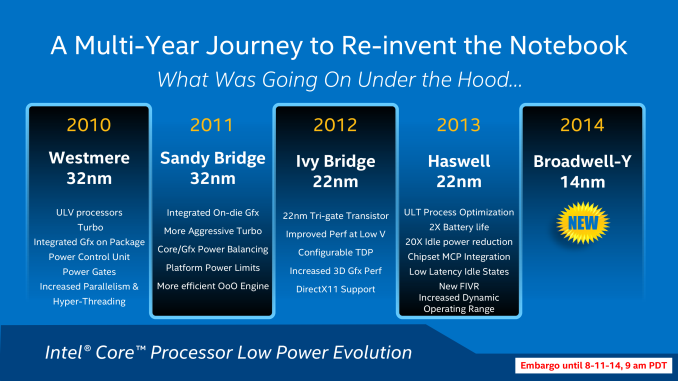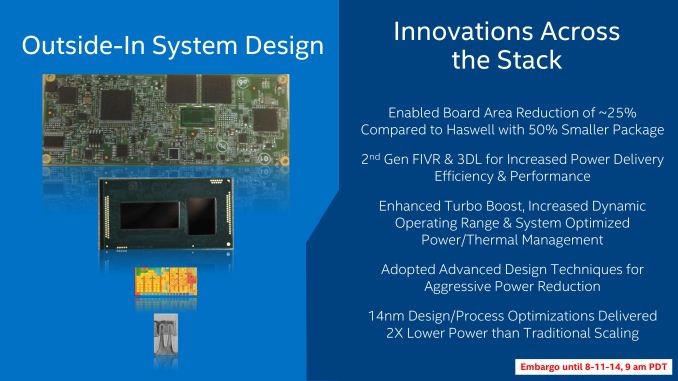Intel Broadwell Architecture Preview: A Glimpse into Core M
by Ryan Smith on August 11, 2014 12:01 PM EST
With Haswell Refresh fully behind us and 2014 now in to its second half, Intel is turning their attention to their next generation of products and processes. Intel’s tick-tock methodology coupled with the long development periods of new products means that the company has several projects in flight at any given time. So while we have seen the name Broadwell on Intel’s roadmaps for some time now, the reality of the situation is that we know relatively little about Intel’s next generation architecture and the 14nm process that it is the launch vehicle for.
Typically we would see Intel unveil the bulk of the technical details of their forthcoming products at their annual Intel Developer Forum, and with the next IDF scheduled for the week of September 9th we’ll see just that. However today Intel will be breaking from their established standards a bit by not waiting until IDF to deliver everything at once. In a presentation coinciding with today’s embargo, dubbed Advancing Moore’s Law in 2014, Intel will be offering a preview of sorts for Broadwell while detailing their 14nm process.
Today’s preview and Intel’s associated presentation are going to be based around the forthcoming Intel Core M microprocessor, using the Broadwell configuration otherwise known at Broadwell-Y. The reason for this is a culmination of several factors, and in all honesty it’s probably driven as much by investor relations as it is consumer/enthusiast relations, as Intel would like to convince consumer and investor alike that they are on the right path to take control of the mobile/tablet market through superior products, superior technology, and superior manufacturing. Hence today’s preview will be focused on the part and the market Intel feels is the most competitive and most at risk for the next cycle: the mobile market that Core M will be competing in.
To that end Intel’s preview is very much a preview; we will see bits and pieces of Broadwell’s CPU architecture, GPU architecture, and packaging, along with information about Intel’s 14nm process. However this isn’t a full architecture preview or a full process breakdown. Both of those will have to wait for Intel’s usual forum of IDF.
Diving into matters then, Core M will be launch vehicle for Broadwell and will be released for the holiday period this year. In fact Intel is already in volume production of the Broadwell-Y CPU and production units are shipping to Intel’s customers (the OEMs) to begin production and stockpiling of finished devices for the holiday launch.
Intel’s decision to initially focus Broadwell on the mobile market comes as the company takes the next step in their plan to extend into the Core processor series into these devices. Arguably, Intel has been slow to response to the rise of ARM devices, whose rapid rise has undercut traditional PC sales and quickly become the biggest threat to Intel’s processor dominance in some number of years. Intel is far from doomed right now, but even they see the potential farther down the line if they do not act.
Intel for their part has responded, but it has taken a step-by-step (multi-year) process that has seen the company progressively build smaller and less power hungry CPUs in order to fit the needs of the mobile market. Since Intel integrated their graphics on-die with Sandy Bridge in 2011, the company has continued to tweak the designs of their products, with Ivy Bridge and Haswell generation products introducing further optimizations and new manufacturing processes. Now on their latest iteration with Broadwell, the company believes they’re turning a corner and have the technology they need to be a leader in the high performance mobile market. It's important to note that despite Intel's best intentions here, Broadwell and Core M remain targeted at premium devices. You won't see these parts in cheap tablets. The duty of doing battle with ARM remains Atom's alone.
Many of these changes ultimately amount to boosting performance and reducing power consumption to a point where power and heat are where they need to be for mobile form factors, either through process efficiency improvements or through better power management and wider dynamic ranges – boosting where it matters and doing a better job of idling between tasks. However as Intel has discovered they not only need to be able to meet the TDP requirements of a tablet but they need to be able to meet the size requirements too. A particularly daunting task when the entire thickness of a device needs to be under 10mm, and the CPU thinner yet.
As a result, coupled with Core M’s performance improvements and power reductions is a strong emphasis on the size of the processor package itself and what Intel could do to reduce it. Intel calls this an outside-in system design, with various parts of Intel focusing on everything from the size of the logic board needed to hold the processor to the thickness of the processor die itself. In the following pages we’ll take a look at Intel’s efforts to get slim, but to kick things off we have a picture of Broadwell-Y from Computex 2014.

From left to right: Broadwell-Y (Core M), Broadwell ULT/ULX and Haswell ULT/ULX
Intel wants a greater foothold in the mobile market and they want it badly. And with Broadwell-Y they believe they finally have what they need to accomplish that goal.














158 Comments
View All Comments
mapesdhs - Monday, August 11, 2014 - link
Yeah, sure, and that's exactly what everyone was saying back when we were waiting for
the followon to Phenom II; just wait, their next chip will be great! Intel killer! Hmph. I recall
even many diehard AMD fans were pretty angry when BD finally came out.
Benchmarks show again and again that AMD's CPUs hold back performance in numerous
scenarios. I'd rather get a used 2700K than an 8350; leaves the latter in the dust for all CPU
tasks and far better for gaming.
Btw, you've answered your own point: if an 8350 is overkill for a game, giving 120fps, then
surely one would be better off with an i3, G3258 or somesuch, more than enough for most
gaming if the game is such that one's GPU setup & sscreen res, etc. is giving that sort of
frame rate, in which case power consumption is less, etc.
I really hope AMD can get back in the game, but I don't see it happening any time soon.
They don't have the design talent or the resources to come up with something genuinely
new and better.
Ian.
wurizen - Monday, August 11, 2014 - link
an fx-8350 isn't holding anything back. come on, man. are you like a stat paper queen obsessor or something? oh, please. an fx-8350 and an amd r9290 gpu will give you "happy" frame rates. i say happy because it i know the frames rates will be high enough. more than good enough even. will it be lower than an i7-4770k and an r90? maybe. maybe the fx-8350 will avg 85 fps on so and so game while the i7-4770k will avg 90 fps. boohoo. who cares about 5 more frames.also, while you mention i3 as a sufficient viable alternative to an fx-8350. remember that the cost will probably be about the same. and fx-8350 is like $190. maybe the i3 is 20 dollars less. but, here's the big but, an i3 is not as good as an fx-8350 in video editing stuff and photo editing stuff if one would like to use their pc for more than just games. an fx-8350, while not as power efficient as an i3 (but who cares since we are talking about a desktop) literally has more bang for the back. it has more cores and is faster.
amd will get back in the game. it is just a question of when. an fx-8350 is already toe-to-toe with an i7-2600k, which is no slouch in todays standard. so, amd just needs to refine their cpu's.
as for talent? amd came up with x64, or amd64 before intel. intel developed their own x86-64 later.
the resource that intel has over amd is just die shrinking. that's it. architecturally, an fx chip or the phenom chip before it seems like a more elegant design to me than intel chips. but that's subjective. and i don't really know that much about cpu's. but, i have been around since the days of 286 so maybe i just see intel as those guys who made 286 which were ubiquitous and plain. i also remember cyrix. and i remember g4 chips. and to me, the fx chip is like a great chip. it's full of compromises and promises at the same time.
Drumsticks - Monday, August 11, 2014 - link
I think AMD might have a way back into the game, but the difference right now is way worse than you say.http://www.anandtech.com/bench/product/697?vs=287
FX-8350 trails the 2600k frequently by 10-20% or more (in gaming).
http://www.anandtech.com/bench/product/697?vs=288
i5-2500k beats it just as badly and actually sells for less than the 8350 used on ebay. Games love single threaded power and the 8350 just doesn't have it.
wurizen - Monday, August 11, 2014 - link
the games they have in that comparison are starcraft 2 and dragon age. 47 fps at 768 p for 8350 looks suspect on starcraft 2. what gpu did they use?it's not way worse as i say. omg.
i have an i7-3770k oc'd to 4.1Ghz and a stock FX-8320 at stock. both can run cod: ghost and bf3. haven't tested my other games. might do the starcraft 2 test tomorrow. i don't have the numbers nor care. what ppl need to realize is the actual game experience while playing games and not the number. is the game smooth? a cpu that can't handle a game will be very evident. this means it's time to upgrade. and there are no fx cpu's from amd that can't handle modern games. again, they will trail intel, but that is like a car going at 220mph so that car wins but the other car is going at 190mph and it will lose but realistically and the experience of going at 190mph will still be fast. the good thing is that amd or cpu don't race each other unless you care about benchmarks. but, if you look past the benchmarks and just focus on the experience itself, an fx series cpu by amd is plenty fast enuff.
omg.
silverblue - Tuesday, August 12, 2014 - link
We're well within the realms of diminishing returns as regards standard CPU IPC. AMD has the most to gain here, though with HSA, will they bother?kaix2 - Tuesday, August 12, 2014 - link
so your response to people who are disappointed that broadwell is focused more on TDP instead of performance is to buy an AMD cpu with even lower performance?wurizen - Tuesday, August 12, 2014 - link
well, they don't have to get the fx-9590, which has serverlike cpu of 2008 like tdp or a gpu like tdp of 220 watts. there is a more modest tdp of 125w with the fx8350. all overclockable. seems like a good cpu for tinkerers, pc/enthusiast, gamers and video editors. i don't even think it's a budget cpu. there is the 6-core and 4-core variants which are cheaper. i am also not saying that an fx-8350 is like the best cpu since it's not and falls way down in the benchmark charts. but, it's not a bad cpu at all. it gets the work done (video editing) and let's you play games (wit's a modern cpu after) even though it's sort of 2 yrs old already. the 990FX chipset is even an older chipset. there's something to be said about that and i think im trying to say it. in light of all the news about intel, which we are guaranteed to get every year with each tick and tock... there is that little AMD sitting in the corner with a chipset that hasn't been updated for yrs and an 8-core cpu that's remarkably affordable. the performance is not that low at all. i mean, video editing with it or playing games with it doesn't hamper one's experience. so, maybe one will have to wait a couple more minutes for a video to render in a video editing program versus say an i7-4790k. but, one can simply get up from one's chair and return. instead of staring at how fast their cpu renders a video on the screen.know what i'm saying?
so, yeah. an fx-8350 with an old 990fx mobo and now intel's upcoming broadwell cpu's with z97 chipsets and all the bells and whistles and productivity for either one will probably be similar. also, most video editing programs now will also leverage the gpu so an old fx-8350 w/ a compatible gpu will have help rendering those gpu's....
i guess it's like new doesn't mean anything now. or something. like m2 sata and pci 3.0, which intel chipsets have over amd is kinda superflous and doesn't really help or do much.
know what im saying?
rkrb79 - Tuesday, November 18, 2014 - link
Agreed!!name99 - Tuesday, August 12, 2014 - link
Oh yes, Skylake.Intel has given 5% IPC improvements for every generation since Nehalem, but now Skylake is going to change everything?
If you're one of the ten people on the planet who can actually get value out of AVX-512 then, sure, great leap forward. For everyone else, if you were pissed off at IB, HSW, BDW, you're going to be just as pissed off with Skylake.
DanNeely - Tuesday, August 12, 2014 - link
No, the interest in Skylake is for all the non-CPU speed things promised with it. PCIe 4.0 and a bump from 16 to 20 CPU lanes (for PCIe storage) are at the top of the list. Other expected, but AFAIK not confirmed, benefits include USB3.1 and more USB3.x on the chipset than the current generation. We should have consumer DDR4 with Skylake too; but that's not expected to be a big bump in the real world.